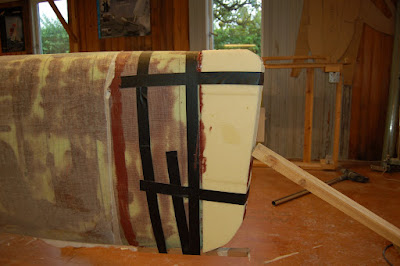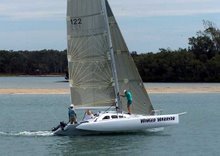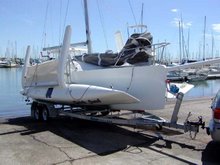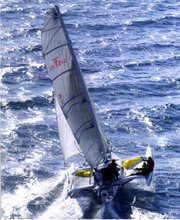

I start by preparing the foam. Cut it 10-20 mm to big (not accurate, but easier to glass over edge and then re-cut precise later. The marking is still there under the glass)
Then making holes. I use to do it with this fakir instrument on first picture, but pulling it out was to tiresome, so now I drill holes, but through both plates at one time ( st board and port side).
 Cutting peelply
Cutting peelply
Cutting glass. Now using a proper pair of scissors (very expensive, but auto-cutting, mind controlled!!), much better than the cheap ones I used in beginning.
 Wet out peel-ply with no wrinkles.
Wet out peel-ply with no wrinkles. Wet out bottom glass.
Wet out bottom glass. Placing foam on top. The rest is the same; glass wet out, peel ply , wrinkles removed by gloved hands. Then comes release film and bleeder.
Placing foam on top. The rest is the same; glass wet out, peel ply , wrinkles removed by gloved hands. Then comes release film and bleeder.Note: I use the same vacuum bag several times, seen on the right, still attached to table at one side. It is more than 20 cm to big all around. When removing it it is like pulling off a bandage, do it quick.
 Vacuum on.
Vacuum on. Finished panel ready to cut. It can be cut with the peel ply left on.
Finished panel ready to cut. It can be cut with the peel ply left on.
Honey comp sheet.
It was to long for the table so I had to cut of a bit seen in front.
 It is not possible to do both sides at ones, the combs would make an impression in top layer. I only make this, because this sheet was a leftover from a repair on the 18 footer cockpit.
It is not possible to do both sides at ones, the combs would make an impression in top layer. I only make this, because this sheet was a leftover from a repair on the 18 footer cockpit. After curing, cleaning the table with a 2 inch chisel, not to sharp and vacuum cleaner. Quite easy and no scratches.
After curing, cleaning the table with a 2 inch chisel, not to sharp and vacuum cleaner. Quite easy and no scratches.




























